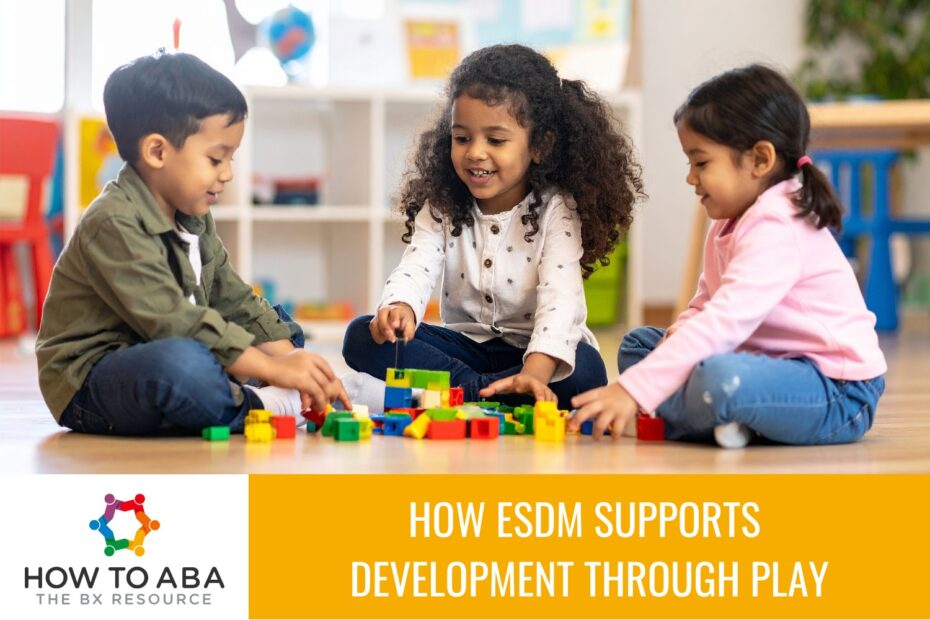If you’ve ever watched a young child at play, you know how magical it can be. A cardboard box becomes a rocket ship, a set of blocks transforms into a tower, and giggles erupt over a silly game of peekaboo.
For children on the autism spectrum, play doesn’t always come as naturally, but it is one of the most powerful ways to encourage learning, connection, and growth. That’s where the Early Start Denver Model (ESDM) shines.
ESDM is a relationship-based, play-centered approach to supporting children with autism, especially toddlers and preschoolers. At its core, it encourages therapists, parents, and caregivers to follow the child’s lead and build meaningful learning moments right into play. By doing this, children develop new skills in a natural, joyful way.
In this post, we’ll explore what it means to “follow the child’s lead,” why play is such an important vehicle for development, and how ESDM uses these principles to support real progress.
What Does It Mean to Follow the Child’s Lead?
When adults picture teaching, they often imagine structured lessons with clear instructions. However, for young children, learning takes on a different form. They’re constantly learning from the world around them, especially during play.
Following the child’s lead means observing what captures their interest and joining them there. Instead of imposing adult-driven activities, the caregiver or therapist uses the child’s natural curiosity as the starting point.
For example:
- If a child is fascinated by stacking blocks, the adult might join in by handing over another block, modeling how to balance one on top, or playfully knocking the tower down together.
- If a child is rolling a toy car, the adult could take another car and mimic the motion, slowly introducing turn-taking or sound effects.
These moments create opportunities for back-and-forth interaction, social connection, and learning, without the child feeling pressured or pulled away from what they enjoy.
Looking for ways to help your learners build play skills beyond the natural environment? Our Play Script Bundle gives you ready-to-use templates (and editable versions!) for common play themes like blocks, kitchen, dolls, vet, and more — perfect for practicing structured, meaningful play.
Why is Play so Important for Development?
Play isn’t just “fun.” It’s how children build the foundation for language, social interaction, problem-solving, and emotional regulation. Through play, children practice:
- Communication skills: using gestures, sounds, or words to express themselves.
- Social reciprocity: learning how to take turns, share attention, and engage with others.
- Cognitive skills: understanding cause and effect, categorizing, and sequencing events.
- Motor skills: fine-tuning hand-eye coordination, balance, and dexterity.
For children on the autism spectrum, some of these skills may develop differently. They might prefer to play alone, repeat the same actions, or focus intently on certain objects. While these play styles are valid, ESDM helps gently broaden a child’s experiences by weaving in social and developmental opportunities during the play they already love.
Why Does Following the Child’s Lead Work?
The heart of ESDM lies in respecting the child as an active participant in their own learning. When children feel heard, understood, and engaged in activities they enjoy, they’re more likely to develop new skills and strengthen their relationships.
Instead of forcing learning, following the child’s lead creates a partnership where development unfolds naturally. Over time, this approach not only helps children meet developmental milestones but also nurtures confidence, curiosity, and joy.
The Role of Parents & Caregivers
One of the strengths of ESDM is its focus on empowering parents and caregivers. Since play occurs naturally throughout the day, parents can apply strategies learned outside of therapy sessions. Here are a few practical tips for parents:
- Observe first. Watch what your child is drawn to before stepping in.
- Join, don’t direct. Add to the play rather than trying to control it.
- Create opportunities. Pause during routines (like snack time or playtime) to encourage communication and interaction.
- Celebrate small wins. Every smile, gesture, or word is progress worth noticing.
By making these small adjustments, everyday interactions become chances for growth.

The Early Start Denver Model in Action
The Early Start Denver Model is a comprehensive, evidence-based approach designed specifically for children with autism between 12 and 48 months old. It integrates principles from Applied Behavior Analysis (ABA) with developmental and relationship-based strategies.
Here’s how ESDM puts the idea of following the child’s lead into practice:
1. Start with the Child’s Interests
Rather than introducing random toys or tasks, the therapist pays close attention to what the child naturally gravitates toward. If a child is drawn to musical instruments, the adult might introduce a simple rhythm game to encourage their interest in music. If the child loves bubbles, the therapist can turn bubble play into an opportunity for requesting, joint attention, and eye contact.
2. Embed Goals Into Play
ESDM doesn’t separate “work time” from “play time.” Developmental goals – such as increasing vocabulary, improving motor imitation, or practicing turn-taking – are seamlessly integrated into activities. This helps the child stay engaged and reduces resistance to learning.
3. Use Positive Reinforcement
The natural joy of play becomes its own reinforcement. Instead of relying solely on external rewards, ESDM utilizes the child’s excitement and shared enjoyment as motivation to continue learning.
4. Encourage Social Connection
Every interaction is an opportunity to strengthen the bond between a child and an adult. ESDM emphasizes warm, responsive relationships, so children not only learn new skills but also experience the comfort and pleasure of connecting with others.
Looking for ways to help your learners build play skills beyond the natural environment? Our Play Scripts Bundle gives you ready-to-use templates (and editable versions!) for common play themes like blocks, kitchen, dolls, vet, and more — perfect for practicing structured, meaningful play.
3 Real-Life Examples of Following the Child’s Lead
To see how this works, let’s look at a few scenarios:
Scenario 1: Playing with Trains
A child loves rolling a train back and forth across the tracks. The therapist joins in with another train, narrating the play (“Choo-choo!”), encouraging eye contact, and later adding turns. Over time, this simple game supports the development of imitation, joint attention, and communication.
Scenario 2: Building with Blocks
Instead of directing the child to “build a house,” the adult watches what the child does first. If the child stacks blocks randomly, the adult can copy their actions and then introduce variations, such as color matching or counting. This keeps the child’s interest while introducing new learning opportunities.
Scenario 3: Bubble Play
A child reaches for the bubbles. The therapist waits for eye contact or a simple request (“more!”) before blowing more bubbles. The fun of watching and popping bubbles encourages communication, turn-taking, and shared joy.
These examples show how everyday play can become a learning opportunity without losing the sense of fun.
Every child learns in their own way, and play provides a universal bridge for connection and growth. The Early Start Denver Model embraces the idea that when adults step into a child’s world of play and follow their lead, incredible things can happen.
For children on the autism spectrum, this approach helps them not only gain communication, social, and cognitive skills but also experience the joy of shared interaction. For parents and caregivers, it provides a meaningful way to bond with their child while supporting their development.
In the end, following the child’s lead isn’t just a strategy – it’s a reminder that every child’s interests and joys are the keys to unlocking their potential.


